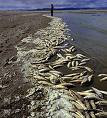


Environmental pollution is the introduction of contaminants into the environment that makes the environment unhealthy for habitation and on the extreme, can harm the ecosystem. The causes of pollution depend on the type of pollution under view.
Air pollution This is the release of polluting chemicals and particulates into the atmosphere. These pollutants makes it unhealthy to breathe in such air. Common air pollutants are sulfur dioxide, chlorofluorocarbons (CFC), carbon monoxide, and nitrogen oxides produced by industry and motor vehicles. When hydrocarbons and nitrogen oxides react to sunlight, smog and photochemical ozone are formed when nitrogen oxides and hydrocarbons react to sunlight.
Water pollution When waste products and potential contaminants are released into river drainage systems and other water bodies making the water unfit or compromising the quality of the water for use by man or habitation of water fauna and flora, we have water pollution.
Soil Contamination occurs when chemicals are released by spill or underground leakage. Among The most significant soil contaminants are hydrocarbons, heavy metals, herbicides, pesticides and chlorinated hydrocarbons.
Radioactive contamination, resulting from 20th century activities in atomic physics, such as nuclear power generation and nuclear weapons research, manufacture and deployment.
Noise pollution, which encompasses roadway noise, aircraft noise, industrial noise as well as high-intensity sonar.
Light pollution, includes light trespass, over-illumination and astronomical interference.
Visual pollution, which can refer to the presence of overhead power lines, motorway billboards, scarred landforms , open storage of trash or municipal solid waste.
Thermal pollution, is a temperature change in natural water bodies caused by human influence, such as use of water as coolant in a power plant.
www.made-from-india.com maintains a trade directory that contains information on pollution control equipment exporter from India, pollution monitoring equipment supplier from India, air pollution control equipment exporters in India, air cleaning equipment, water treatment plant exporters, environment protection products supplier form business to business trade India.






